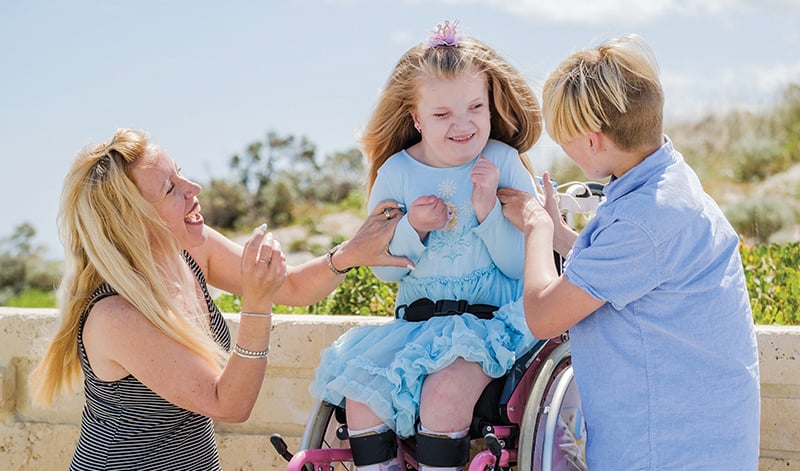
Mum Laura, Charlotte and brother Josh
For thousands of WA children living with undiagnosed diseases, it’s hope. The computational biology team, a founding group of the new precision health program at The Kids, is relentlessly pursuing technologies that can give more children the name they seek – a diagnosis – in research that is at the frontier of this field.
Charlotte brings her family so much joy.
And while Perth mum Laura West has an abundance of love for her daughter, she also has so many unanswered questions.
“People say, ‘What’s wrong with her’ and I actually have nothing to say when people ask the question. Doctors scratch their heads and say this shouldn’t be happening,” Laura said.
With Charlotte having already been through 60 surgeries and countless tests and procedures, nobody knows what treatments might be most effective or, sadly, how long she will be with her family.
Imagine Optus Stadium seated at capacity with 63,000 children. That’s approximately the number of children, just like Charlotte, living with a rare disease in Western Australia, yet more than 70 per cent of children suffering from a rare disease remain undiagnosed.
This enormous number translates into an equally heavy burden of suffering and uncertainty across our community.
It takes an average of five to seven years for a child with a rare disease to get a diagnosis – a journey that can be substantially longer in the most challenging cases. A diagnosis provides clarity – a powerful breakthrough that can connect these children with critical therapies or even, one day, a cure. Additionally, it provides a valuable connection to other children and families around the world who are suffering from the same condition, reducing feelings of isolation.
Research can get us there.
The Kids Research Institute Australia is discovering and delivering new solutions to end the diagnostic odyssey, along with new insights and pathways that, importantly, bridge diagnosis with care.
The genomics revolution means we can now detect tiny variations in DNA, which are uniquely different in every individual and which may be the cause of symptoms.
Our Institute is the catalyst for a collaboration of specialised teams of clinical geneticists, mathematicians, computer and laboratory scientists finding answers for each child.
Rare diseases expert Gareth Baynam and computational biologist Feilman Fellow Timo Lassmann head up the Institute’s pioneering team of disease detectives. They have seen many patients, most of them children, who suffer with severe conditions and who have spent years without answers – something Professor Baynam says has become a global child health issue.

The team gathers medical information about a child, shares it with specialists the world over, and searches global genetic population databases to look for similar disease symptoms.
Complementing this is world-first technology developed by Dr Lassmann and his team. Together, they created a computer algorithm that searches individuals’ genes for the specific variation causing the disease.
Developing innovative algorithms is challenging research work and can take the team years. Once developed, however, the algorithm can be applied within mere hours. Thanks to this work, the team now can diagnose around 60 per cent of cases – ten per cent more than when it started.

“We integrate this information with the clinical descriptions of what’s wrong with the child to find the needle in the haystack – the one mutation in 100,000 that may cause the disease.”
Diagnosis means more than an answer. It also means a reduction or end to costly and invasive tests, and opens up access to treatments, therapies, medication, and disability funding.
“There is so much urgency and responsibility to be able to do this better at an even greater scale,” Professor Baynam said.
Laura has seen first-hand some of the research in action with Charlotte.
“She went from complete immobility to being able to walk,” Laura said. “This research may be able to give us closure … ideas about what our future might look like.”
What's next
- Dr Lassmann is developing original algorithms to pinpoint the likely cause of disease faster. Simultaneously, our lab researchers are developing new assays to more rapidly validate the function of hundreds of variants in parallel. Taken together, the research aims to end the diagnostic odyssey for families in WA
- In addition to his work at The Kids, Dr Lassmann is helping to ramp up global progress on rare diseases. In recognition of his considerable expertise, he was recently asked by the International Rare Diseases Research Consortium (IRDiRC) to join a newly formed taskforce focused on integrating new technologies for the diagnosis of such diseases
